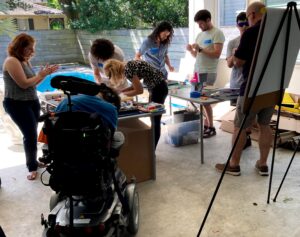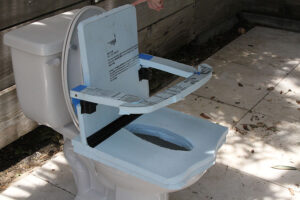While the New Orleans Makers Making Change (opens in a new window) chapter (opens in a new window) is only a few months old, they’ve made tremendous progress on their first big project — the Portable Adaptive Toilet, or as they call it, the ‘One-to-Geaux.’

“If you have a child with cerebral palsy, and you go anywhere out of the house, how do they use the bathroom? That’s the base question,” says chapter leader Noam Platt.
The idea came from Jen Lyman, whose son, Bower, has quadriplegic cerebral palsy,
and they have been working with Noam and his volunteers on the device. The device would be for individuals who have cerebral palsy (opens in a new window) or other disabilities who have poor trunk control and cannot sit up independently without support, and need help getting on and off a toilet.
While there are similar devices on the market, they are expensive, not covered by insurance, and they don’t particularly work well for many people.
“There’s nothing on the market that’s truly portable, that you can wear it as a backpack or carry it lightweight, hang it on the back of a wheelchair,” says Jen. “It would be hugely meaningful and life changing for Bower, because when we travel, and we travel a lot, it’s a real pain in the butt.
“The idea is to have something made that wouldn’t just benefit him, but would benefit a lot of people and be affordable.”
They have two prototypes for the device, developed after a few months of meetings, ideas going back and forth, and most importantly, a makeathon at the end of May on Jen’s patio, where Noam, Jen, Bower, and a group of makers all came together to put their ideas to action.
“The adaptive toilet seat is the most important project I’ve ever worked on,” says Noam. “I believe it will have the most impact on people’s day-to-day lives.”
Coming Together

Chapter leader Noam Platt explains the project.
In his day job, Noam is a healthcare architect, mostly designing hospitals and clinics, so he’s no stranger to designing things that make a big difference in people’s lives.
When he was younger, Noam was a counsellor at Camp Dream Street (opens in a new window), a five day camp for children with disabilities. Later in 2015, he took part in one of the early Tikkun Olam Makers (opens in a new window) (TOM) makeathon events in San Francisco, where he helped design a grabber device.
After participating in another TOM makeathon in Washington, DC, Jen reached out to him, seeing his name in a Washington Post story (opens in a new window) about the event and noticing that he was also from New Orleans.
Jen, a cerebral palsy advocate, had done a survey asking parents and people with cerebral palsy what they needed, and she says overwhelmingly the over 230 respondents wanted an adaptive toilet that would cost “$200, $250 or less that could easily be carried with you when you’re traveling from place to place, and easily put over a regular toilet, so easy to put together, easy to take apart, and lightweight and affordable, and provide support.”
They became good friends, but the project largely sat dormant.
After the pandemic hit, Noam decided he wanted to become more involved in the maker community and dedicate more of his time to helping people with disabilities. Having learned of Makers Making Change, he decided to take the plunge and start up a chapter at the beginning of 2021.
“The pandemic, I think it crystallized for a lot of people what was important,” he explains. “I was sitting around thinking about when did I feel the best, when did I feel like I was being the most useful and making use of my skills, and it was at the TOM events.
“I thought this is going to be a good opportunity for me to re-engage with this sort of work with this community, and really bring some of my skills I’ve developed even since 2016 in healthcare design and 3D modeling, and even just leading design teams, into this field.
“There’s a huge need for assistive technology and devices down here [in Louisiana].”
Since then, he’s been an active volunteer, having printed and given away many devices — including about 15 pen balls. He’s also designed a mouthstick holder, which he’s delivered to a couple of Makers Making Change forum (opens in a new window) users. He’s also formed a group called MakeGood (opens in a new window).
“I’m super happy to be with Makers Making Change, it’s been one of the most positive things I’ve ever done in my life, it’s brought me considerable awareness, just more empathy and more understanding for other people, and if I’m able to help a few people along the way, that’s a huge win for me,” he says.
Patio Makeathon

Jen and Bower shaping clay for a tiny toilet.
After a few months of design sessions on the ‘One-to-Geaux,’ with fellow local architect James Catalano joining in, they hosted a Makeathon in Jen’s backyard to really get the process going.
“I could sit in my backyard with cardboard and hot glue, and I could do it myself — it’s not rocket science. But when you have groups of people from different backgrounds, you get such a diversity of thought and ways to approach problems, you just end up with better solutions,” Noam explains.
“When I’m doing an architecture project, the first thing you draw is always wrong — always wrong. You just kind of have to learn to accept that. You have to accept that there’s lots of work ahead of you, and it’s just gonna take time. And that’s what I’ve learned to accept. But when you get groups of people together, what might take you four months, can take you four hours.”
To start the process, everyone designed a tiny toilet, using clay and cardboard, which Noam and Jen judged. The winning tiny toilet inspired one of the full-sized prototypes.

Tiny Toilets.
With prizes for prototypes, ideas, and even puns and cardboard, the idea was to encourage everyone to contribute their ideas and see that they were valued.
“It really got the creative energy flowing, and it really allowed people to be free-thinking,” he says. “I think it’s really important to set people up for success and give them the tools they need to try ideas, and those tools in this case were modeling clay and cardboard.”
Some of the participants had no prior experience doing anything like this, and they all contributed valuable ideas.
“When you have an environment where people feel like they aren’t gonna be judged, and people feel like they have the freedom to express their ideas — you’ve gotta make people comfortable — and then it just flows naturally,” Noam explains.
They were able to garner feedback and get critiques from Jen and Bower.
“I think they appreciate my feedback,” Jen says. “It was really fun to have them come to the house and to make a bunch of little tiny toilets, and for everybody to have a different design and explain exactly why. I think we had 12 different designs, and everyone had different ideas on how they would stay on the toilet. It was really cool, it was a really neat experience.”
Using materials like cardboard and foam, and toilets donated by construction connections, the makers then split into two teams and built two full-size prototypes.

Above: A three piece prototype consisting of a back, seat, and safety bar. The seat locks into place over the 3D-printed clamps that hold the back to the toilet structure.
Below: A folding prototype utilizing hidden legs and fold out arms.
The next step is another, bigger-scale makeathon to develop the two prototypes into a more final design, which they are planning to hold later this summer.
“All it takes is empathy,” Noam says. “That’s why I think those makeathons are really useful. You can have people from all these different backgrounds, and as long as they have empathy and can listen, they will have really good ideas.”
“I’m just tremendously grateful for the volunteers and the people at Makers Making Change, who have decided to give back to people with disabilities, and to use their talents and their time to make this world a little bit more inclusive and a little bit more accessible for people who might need a little bit of extra help,” says Jen.
This post originally appeared on the Makers Making Change (opens in a new window) website.

